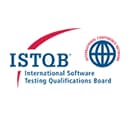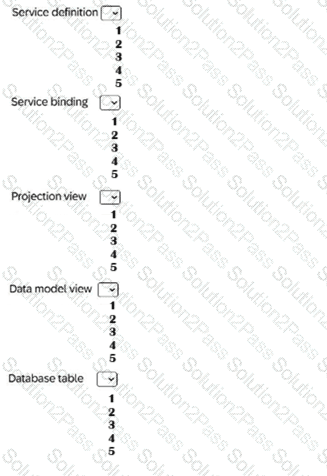SAP C_ABAPD_2507 Practice Test Questions Answers
Exam Code: C_ABAPD_2507
(Updated 80 Q&As with Explanation)
Exam Name: SAP Certified Associate - Back-End Developer - ABAP Cloud
Last Update: 08-Dec-2025
Demo:
Download Demo
Questions Include:
C_ABAPD_2507 Overview
SAP Related Exams
- C_THINK1_02 Dumps
- C_BW4H_211 Dumps
- C_C4H320_34 Dumps
- C_C4H620_34 Dumps
- C_CPE_16 Dumps
- C_BW4H_214 Dumps
- C_SIGPM_2403 Dumps
- C_ACT_2403 Dumps
- C_DBADM_2404 Dumps
- C_HAMOD_2404 Dumps
- C_TS4FI_2023 Dumps
- C_TS4CO_2023 Dumps
- C_WZADM_2404 Dumps
- C_S4FCF_2023 Dumps
- C_S4FTR_2023 Dumps
- C_TS422_2023 Dumps
- C_ARCIG_2404 Dumps
- C_LIXEA_2404 Dumps
- C_S4EWM_2023 Dumps
- C_THR82_2405 Dumps
- C_THR92_2405 Dumps
- C_THR95_2405 Dumps
- C_THR96_2405 Dumps
- C_THR97_2405 Dumps
- C_ARP2P_2404 Dumps
- C_ARSOR_2404 Dumps
- C_HRHPC_2405 Dumps
- C_THR85_2405 Dumps
- C_THR89_2405 Dumps
- C_THR87_2405 Dumps
- C_THR88_2405 Dumps
- C_THR94_2405 Dumps
- C_IEE2E_2404 Dumps
- C_THR86_2405 Dumps
- C_LCNC_2406 Dumps
- C_C4H51_2405 Dumps
- C_ARSUM_2404 Dumps
- C_C4H41_2405 Dumps
- C_C4H62_2408 Dumps
- C_S43_2023 Dumps
- C_SAC_2415 Dumps
- C_THR84_2405 Dumps
- C_STC_2405 Dumps
- C_TFG51_2405 Dumps
- C_C4H63_2411 Dumps
- C_TS452_2410 Dumps
- C_C4H45_2408 Dumps
- C_SAC_2421 Dumps
- C_C4HCX_2405 Dumps
- C_THR89_2411 Dumps
- C_THR84_2411 Dumps
- C_SIGBT_2409 Dumps
- C_THR87_2411 Dumps
- C_THR86_2411 Dumps
- C_THR96_2411 Dumps
- C_THR95_2411 Dumps
- C_THR82_2411 Dumps
- C_THR85_2411 Dumps
- C_THR83_2411 Dumps
- C_THR97_2411 Dumps
- C_THR94_2411 Dumps
- C_AIG_2412 Dumps
- C_SEC_2405 Dumps
- C_THR92_2411 Dumps
- C_HRHFC_2411 Dumps
- C_CPE_2409 Dumps
- C_C4H22_2411 Dumps
- C_BCHCM_2502 Dumps
- C_BCSBN_2502 Dumps
- C_BCBAI_2502 Dumps
- C_BCSSS_2502 Dumps
- C_BCSBS_2502 Dumps
- C_BCSCX_2502 Dumps
- C_BCBTP_2502 Dumps
- C_BCSPM_2502 Dumps
- C_BCFIN_2502 Dumps
- C_C4H32_2411 Dumps
- C_FIOAD_2410 Dumps
- C_HRHPC_2411 Dumps
- C_SAC_2501 Dumps
- C_OCM_2503 Dumps
- C_TS470_2412 Dumps
- C_C4H47_2503 Dumps
- C_FIORD_2502 Dumps
- C_WME_2506 Dumps
- C_S4PM_2504 Dumps
- C_BCBDC_2505 Dumps
- C_BCWME_2504 Dumps
- C_S4CS_2502 Dumps
- C_S4CFI_2504 Dumps
- C_S4CPR_2502 Dumps
- C_C4H56_2411 Dumps
- C_BCBTM_2502 Dumps
- C_TS410_2504 Dumps
- C_TS422_2504 Dumps
- C_BW4H_2505 Dumps
- C_THR85_2505 Dumps
- C_THR92_2505 Dumps
- C_THR82_2505 Dumps
- C_THR94_2505 Dumps
- C_THR86_2505 Dumps
- C_THR87_2505 Dumps
- C_THR95_2505 Dumps
- C_THR83_2505 Dumps
- C_THR88_2505 Dumps
- C_THR96_2505 Dumps
- C_THR89_2505 Dumps
- C_THR70_2505 Dumps
- C_S4CCO_2506 Dumps
- C_SIGVT_2506 Dumps
- C_TB120_2504 Dumps
- C_THR81_2505 Dumps
- C_CPI_2506 Dumps
- C_THR88_2411 Dumps
- C_THR84_2505 Dumps
- C_THR97_2505 Dumps
- C_ACDET_2506 Dumps
- C_S4CPB_2508 Dumps
- C_S4CS_2508 Dumps
- C_ARCIG_2508 Dumps
- C_S4PM2_2507 Dumps
- C_ARSUM_2508 Dumps
- C_ARCON_2508 Dumps
- C_BCBAI_2509 Dumps
- C_ARP2P_2508 Dumps
- C_S4CPR_2508 Dumps
- C_BCBTM_2509 Dumps
Reliable Solution To Pass C_ABAPD_2507 SAP Certified Associate Certification Test
Our easy to learn C_ABAPD_2507 SAP Certified Associate - Back-End Developer - ABAP Cloud questions and answers will prove the best help for every candidate of SAP C_ABAPD_2507 exam and will award a 100% guaranteed success!
Why C_ABAPD_2507 Candidates Put Solution2Pass First?
Solution2Pass is ranked amongst the top C_ABAPD_2507 study material providers for almost all popular SAP Certified Associate certification tests. Our prime concern is our clients’ satisfaction and our growing clientele is the best evidence on our commitment. You never feel frustrated preparing with Solution2Pass’s SAP Certified Associate - Back-End Developer - ABAP Cloud guide and C_ABAPD_2507 dumps. Choose what best fits with needs. We assure you of an exceptional C_ABAPD_2507 SAP Certified Associate - Back-End Developer - ABAP Cloud study experience that you ever desired.
A Guaranteed SAP C_ABAPD_2507 Practice Test Exam PDF
Keeping in view the time constraints of the IT professionals, our experts have devised a set of immensely useful SAP C_ABAPD_2507 braindumps that are packed with the vitally important information. These SAP C_ABAPD_2507 dumps are formatted in easy C_ABAPD_2507 questions and answers in simple English so that all candidates are equally benefited with them. They won’t take much time to grasp all the SAP C_ABAPD_2507 questions and you will learn all the important portions of the C_ABAPD_2507 SAP Certified Associate - Back-End Developer - ABAP Cloud syllabus.
Most Reliable SAP C_ABAPD_2507 Passing Test Questions Answers
A free content may be an attraction for most of you but usually such offers are just to attract people to clicking pages instead of getting something worthwhile. You need not surfing for online courses free or otherwise to equip yourself to pass C_ABAPD_2507 exam and waste your time and money. We offer you the most reliable SAP C_ABAPD_2507 content in an affordable price with 100% SAP C_ABAPD_2507 passing guarantee. You can take back your money if our product does not help you in gaining an outstanding C_ABAPD_2507 SAP Certified Associate - Back-End Developer - ABAP Cloud exam success. Moreover, the registered clients can enjoy special discount code for buying our products.
SAP C_ABAPD_2507 SAP Certified Associate Practice Exam Questions and Answers
For getting a command on the real SAP C_ABAPD_2507 exam format, you can try our C_ABAPD_2507 exam testing engine and solve as many C_ABAPD_2507 practice questions and answers as you can. These SAP C_ABAPD_2507 practice exams will enhance your examination ability and will impart you confidence to answer all queries in the SAP C_ABAPD_2507 SAP Certified Associate - Back-End Developer - ABAP Cloud actual test. They are also helpful in revising your learning and consolidate it as well. Our SAP Certified Associate - Back-End Developer - ABAP Cloud tests are more useful than the VCE files offered by various vendors. The reason is that most of such files are difficult to understand by the non-native candidates. Secondly, they are far more expensive than the content offered by us. Read the reviews of our worthy clients and know how wonderful our SAP Certified Associate - Back-End Developer - ABAP Cloud dumps, C_ABAPD_2507 study guide and C_ABAPD_2507 SAP Certified Associate - Back-End Developer - ABAP Cloud practice exams proved helpful for them in passing C_ABAPD_2507 exam.
















